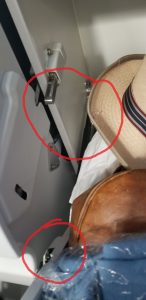Why user testing matters!

This morning I boarded a Delta flight on an Airbus A321, hung my jacket, stowed my briefcase and found a seemingly safe place for my hat in an overhead bin corner. Oddly, the bin took a couple of pushes and shoves to close, but I thought nothing of it, until I fetched my hat back at the end of the flight, whereupon I found a hole punched right through it by the latch mechanism, see photo.
As far as I can tell, with the flight attendant corroborating, this overhead bin design is unique to the Airbus A321s in Delta’s fleet. There is no side protection, hence any jacket, sweater or soft object that projects over what little bin edge there is will either jam it, thus slowing down boarding as passengers search for the invisible blockages, be squished or engage the latch and end up torn or perforated. All sorts of soft goods are at risk and I’m glad I did not lose a favorite blazer.


This is a truly terrible design that I am amazed this was not caught in user testing by Airbus, Delta or whatever company outfitted the cabin. In contrast, most modern bins that fold up (as opposed to have doors) have full sidewalls and unexposed latches, see photo from my next flight on an A350-900. Furthermore, according to the crew, the A321 bins are extra small, never holding more than 75% of the passengers’ luggage; hence the long line of gate checked bags in the jet bridge. Unfortunately, Delta has 97 of these aircraft in the fleet, presumably all similarly equipped, and 100 A321neos on order for a major fleet renewal.
Where other carriers have worked hard to cheese pare, Delta has consistently improved the comfort and service onboard, so I am forwarding this note and asking them to reconsider this design. Overall, this highlights the importance of hands-on user testing, under realistic full (passenger + paraphernalia) load conditions to identify unexpected failure modes.

